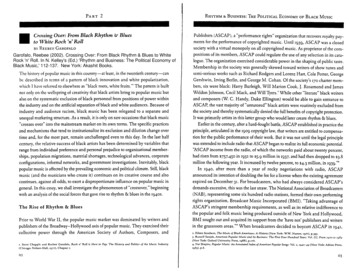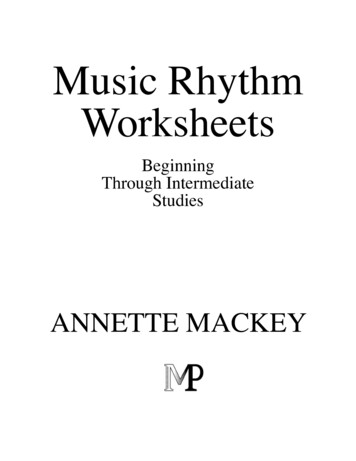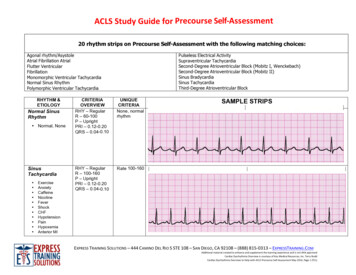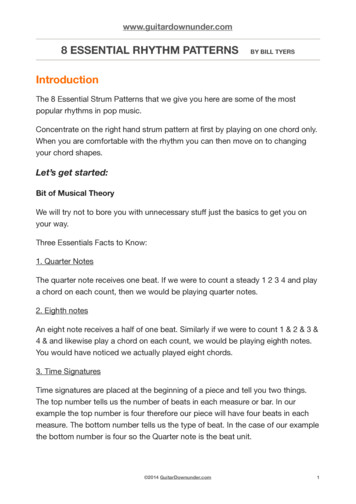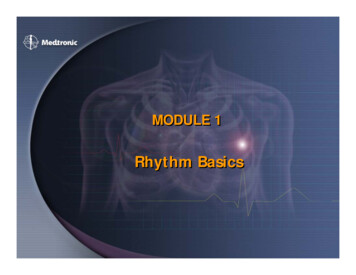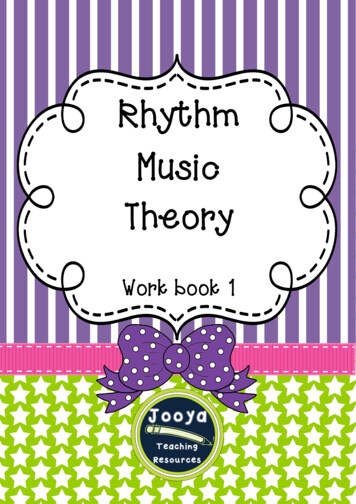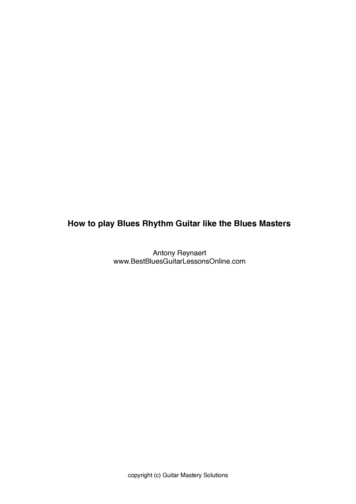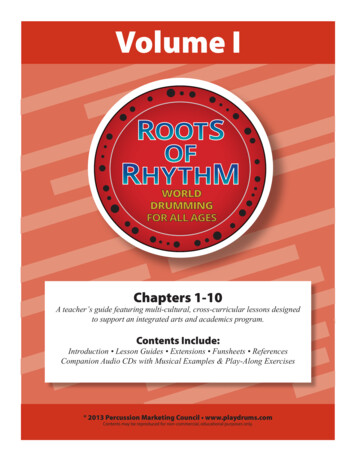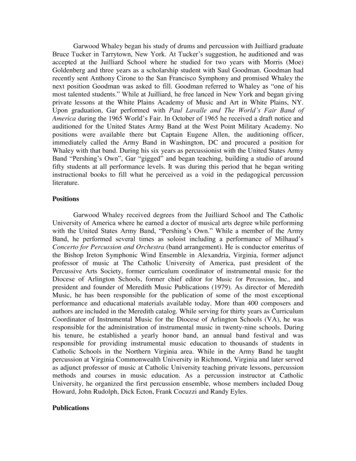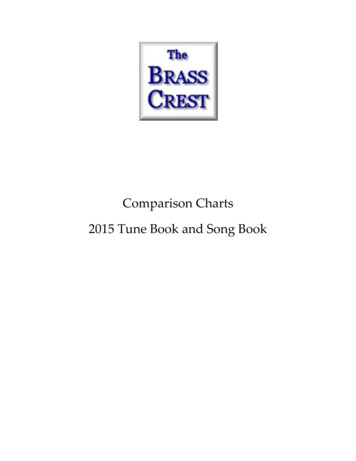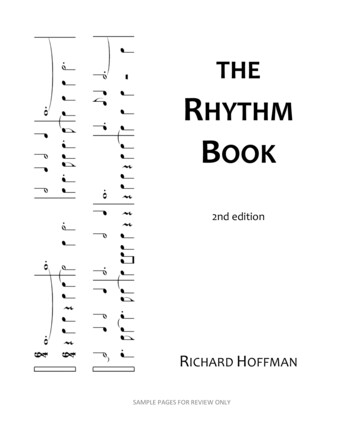
Transcription
THERHYTHMBOOK2nd editionRICHARD HOFFMANSAMPLE PAGES FOR REVIEW ONLY
THE RHYTHM BOOK(SAMPLE PAGES)2nd editionRICHARD HOFFMANBelmont UniversitySmith Creek Music Nashville, etSAMPLE PAGES FOR REVIEW ONLY
for Benjamin and Caleb 2nd editionCopyright 2009 by Richard Hoffmanby arrangement withSmith Creek MusicP.O. Box 140446Nashville, TN 37214www.smithcreekmusic.comAll rights reserved. No portion of this publication may bereproduced in any form or by any means without the expresswritten permission of the copyright holder.Printed in Nashville, TennesseeThe United States of AmericaSAMPLE PAGES FOR REVIEW ONLY
CONTENTSOn studying rhythm .iv1.Getting started . 12.Simple meter . 73.Pick-up notes . 154.Second division of the beat . 205.Dots and ties . 306.Compound meter . 397.Ties in compound meter. 538.Multiple dots, extended ties, third division . 609.Syncopation . 6610.Triplets and duplets . 7511.Two against three . 8112.Changing meter I — Regrouping beats . 8713.Changing meter II — Equal beats . 9314.Changing meter III — Equal divisions . 10115.Superduplets and supertriplets . 10816.Irregular divisions of the beat . 11517.4:3 relationships . 11918.Asymmetric meters — 5 and 7 divisions . 12619.Asymmetric meters — Other groupings . 13220.Complex issues in rhythm and meter . 13921.Rhythm and meter — Early music and modern music . 147Appendix — Performance terms . 161SAMPLE PAGES FOR REVIEW ONLY
On studying rhythm — Notes for students and teachersMusic is sometimes defined as ―sound organized in time.‖ A large part of the temporal or―time‖ element of music is what we commonly call rhythm. I should be clear from the beginning that what we are really studying is for the most part ―Western tonal rhythm‖ therhythm that developed along with Western tonal music. Western tonal music refers tomusic derived from the art music and to some extent the folk music of western Europe overthe last 400 years or so. Tonality, the organization around a focal pitch we call ―tonic,‖ isthe most distinctive feature of this music. It is so pervasive in European-American culturethat we often take it for granted. The rhythm of tonal music is also distinctive, and verydifferent from the rhythm of music that is not tonal or music from other parts of the world.How these musical traditions are different is not terribly important right now, but we shouldacknowledge that the kind of rhythm we are studying is the kind found in Western tonalmusic.Using this book will help you learn to read and understand tonal rhythm, and perform it accurately and confidently. Don‘t rush too quickly through the early, seemingly easy exercises. From the outset work carefully to build good habits, to master the conducting beatpatterns, and to learn to pay attention to tempo, dynamics, and articulation markings. It isfine to perform the exercises in ways other than those specified—with other tempos orarticulations—but they should never be done in a thoughtless and unmusical way.Always perform musically. Listen for the phrases and gestures that move the music along.The idea that music has a sense of forward motion is very much a characteristic of tonalmusic. Don‘t neglect the motion just because you are working primarily with rhythm. If anexercise begins with a pick-up, subsequent phrases are likely also to begin with a pick-up.Breathe at the phrases breaks (notated or not) and not after the first note of two of the newphrase. Never perform the exercises in a boring monotone. Use your voice to show the direction of the line, the high and low points, and cadences.There are six types of exercises in the book.Single parts These exercises are the most common, and are usually designed to addressspecific issues or introduce new material. Even on a simple, single-line exercise,always perform musically, interpreting the phrases and gestures in a way that showsyou understand the musical structure.Ensembles (duets and trios) These are intended for more than one performer. Alwayslearn all the parts, and switch parts often in performance.Speak and clap These are intended for a single performer to speak one part and clapthe other. Typically you should speak the top line and clap the lower, but occasionally switching parts is good practice.SAMPLE PAGES FOR REVIEW ONLY
Layering These exercises combine repeated patterns or ostinatos in various ways. Youcan repeat each pattern an agreed upon number of times, or allow the performers todetermine how and how often the parts are to be repeated. Occasionally ostinatosare provided for other single line exercises. You may layer these in a variety ofcreative ways as well. Layering patterns and ostinato rhythms in this way is moreakin to certain African and East Asian styles of music.Improvise in the blanks These exercises have blank measures in which you shouldimprovise rhythm. Try to use rhythms that relate to the exercise. Always pay attention to the music that comes before and after, and make sure your improvisedmaterial fits.Real music These exercises are written on a staff to give practice reading rhythm in amore familiar musical setting. Although these are still primarily rhythm exercises,use the cues of contour and phrasing to give a musical performance.In addition to the rhythm exercises, there are both pre-notational and written exercises. Dothese exercises as they occur, and use them as models to create your own supplementalexercise.Other suggestions for practiceEcho rhythm. Speak or clap rhythms to a study partner, and have the partner respond onTakadimi syllables. This is a very effective way to learn rhythm, and should come beforereading and writing with notation.Experiment. Include the element of pitch. Singing rhythm on one repeated pitch putsstrain on your voice and is not recommended. But singing on a scale or even improvising amelody is great practice and strongly encouraged. When singing scales sometimes it is easier and more sensible to change pitches with each beat or even each measure.Be creative. Use the exercises in the book as a basis for creating your own exercises. Forexample you might add ostinatos or improvised clapping parts where none is given, or consider the given exercise the first phrase of a two phrase period, and improvise a subsequentphrase. There are many ways to expand on the framework given in the text. Through playis a natural way to learn new skills. Think of all you learned as a child just by playing.Find creative ways to ―play‖ with rhythm. It will make learning fun and effective.Multi-task. It is fine to work just on the rhythm when learning a new concept or workingout a challenging pattern, but it is important to add other elements to your performance asyou become more proficient. Once you have overcome the technical challenges of an exercise, always conduct, clap, sing pitches, or do something else to expand your performance.Rarely in real music do we focus solely on rhythm. Even in percussion music, performersare thinking about timbre, style, and musical expression, even when playing a singlerhythmic line.SAMPLE PAGES FOR REVIEW ONLY
Special thanksSpecial thanks are owed to Nashville composer and percussionist David Madeira. Davidworked with me especially on the later chapters in the book to write examples that werechallenging and reflecting current musical trends.TakadimiTakadimi is the system of rhythmic solfege used throughout the book. It does for rhythmwhat ―do re mi‖ solfege does for pitch. It gives us a way to label the parts of a rhythm andcan make it easier both to understand and to perform. Takadimi is beat oriented; that is, itassigns syllables based on the position of the note within the beat. It is also pattern based.Reading rhythm with Takadimi helps you learn to recognize rhythmic patterns and seegroupings of notes, not simply read note to note. Reading rhythm this way is similar to theway we read groups of letters as words and not one letter at a time. The word ―takadimi‖ issimilar to a pattern used in the complex system of chanted sounds used to learn Indiandrumming. Indian music is not metric in the way tonal rhythm is, and so its use in thatsystem is entirely different from the way we use it here.The Takadimi system as described in this book was developed in the early 1990s by severalmembers of the theory faculty at Ithaca College in Ithaca, New York. The article thatintroduced the system was co-authored by Richard Hoffman, William Pelto, and John W.White, and titled ―Takadimi: A Beat-Oriented system of Rhythmic Solfege,‖ and publishedin the Journal of Music Theory Pedagogy (1994). The article thoroughly explains thesystem and shows its relation to other similar system of learning rhythm.I must thank my co-authors, Bill Pelto and John White, as well as the others who workedwith us from the early stages of Takadimi, especially: John Benoit, Craig Cummings, andTimothy Nord. I must also thank the many teachers in schools across the country who havesuccessfully used Takadimi, and in so doing have continued to add to its pedagogical value.Thanks are owed my colleagues at Belmont University who have used Takadimi and thisbook, especially Kris Elsberry, Deen Entsminger, Todd Kemp, Brent Gerlach, DavidMadeira, Caleb Weeks, and Margie Yankeelov. Their insight and skillful application in theclassroom have been both an inspiration and a very practical help. Finally, I must thank themany students who have learned rhythm with Takadimi and showed us what worked andwhat didn‘t, and most of all, inspired us to keep trying.SAMPLE PAGES FOR REVIEW ONLY
1 Getting started with rhythm and meterPulse and beatMost Western tonal music, which includes most classical music and virtually all Americanpopular and folk music, maintains a sense of steady pulse. This is why you can clap to it,dance to it, or march to it. It is also why we can have a sense of speeding up or slowingdown. Not all music works this way, but most does, and that is where our study begins.The easiest way to understand pulse is to experience it. Sing any familiar song and clapalong at a steady rate. You are clapping a pulse. I say a pulse because actually there aremany levels of pulse in most music. Try clapping a pulse that is faster or slower than theone you started with. Each represents a different level of pulse.The beat is one specific level of the pulse. Usually what we feel as ―the beat‖ falls withinthe range of about 60 – 180 beats per minute, roughly within the range of the human heartbeat. Musicians might sometimes disagree about which level of the pulse is the beat, andsome-times there is no one right answer.MeterMeter is the grouping of beats into patterns of strong and weak accents. In the analysis ofmeter, a dash indicates a strong beat and a curved line indicates a weak beat, like this: strong weak strongweak There are three common metric groupings:duple meter (2 beats) triple meter (3 beats) quadruple meter (4 beats) Duple meter groups two beats together in the pattern: ―accented — unaccented‖ or ―strong— weak.‖ Speak this pattern and clap on the word ―strong.‖ The song ―Three Blind Mice‖is in duple meter. Sing the song and clap on the accented beat. Three blind mice, Three blind mice, see how they run, see how they run . . . etc.SAMPLE PAGES FOR REVIEW ONLY
2 Simple meterSimple meters have beat notes that can be divided into two divisions. Here are somefamiliar songs in simple meter. Clap the beat, then clap the division. What other familiarsongs can you name?Jingle BellsAuld Lang SyneMy Country ‗Tis of TheeYankee DoodleTakadimi (see preface for more on the history of the system)Takadimi is a system of syllables used for speaking rhythm. The system is beat oriented.In other words, the beat is always spoken on ta regardless of the note value. Rememberthat the beat is just one level of the pulse. The next faster level of the pulse is called thefirst division of the beat (or sometimes called simply the division of the beat). A note onthe first division of the beat is always called di.Echo-rhythm: With your study partner or instructor, speak or clap and speak back shortrhythms using ta and ta di rhythms. Speak musically and expressively.Performance tips Always speak rhythm exercises expressively. Even when phrasemarking or dynamics aren’t given, perform the rhythm musically. Always conduct or keep the beat in a way assigned by your instructor.Conduct the appropriate pattern as you perform the following rhythms.2.1tatata di
Using this book will help you learn to read and understand tonal rhythm, and perform it ac-curately and confidently. Don‘t rush too quickly through the early, seemingly easy exer-cises. From the outset work carefully to build good habits, to master the conducting beat patterns, and to learn to pay attention to tempo, dynamics, and articulation markings. It is fine to perform the exercises in .File Size: 727KBPage Count: 29
